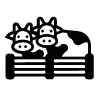|
HOW TO PREPARE THE LAND? Prior to land preparation, all plants, tree branches, logs and others must be cleared. Drainage is a necessity in wet areas.
There are 3 levels of land preparation, namely: i. Ploughing ii. Brushing/Breaking iii. Rotating These activities should be implemented at the beginning of the dry season and every level must be done properly to get the right soil structure as well as improving its water retention ability for root growth and development.
|
| Jenis tanaman dan bentuk pengurusan |
Kadar baja (kg/hektar/tahun) | |
| Rumput tulin - pengurusan secara ragutan |
150 - 200 N 40 - 60 P 50-100 K |
(326-345 Urea) (199-298 TSP) (100-200 MP) |
| Rumput tulin - Pengurusan secara potong dan angkut |
200 - 300 N 40 - 60 P 100 - 150 K |
(435-652 Urea) (199-248 TSP) (200-300 MP) |
| Rumput bercampur kekacang - Pengurusan secara ragutan |
40 - 50 P 50 - 100 K |
(199-248 TSP) (100-200 MP) |
| Rumput becampur kekacang - Pengurusan secara potong dan angkut |
50 - 60 P 150 - 200 K |
(248-298 TSP) (300-400 MP) |
| Petai Belalang / Ipil-ipil | 40 - 60 P 50 - 100 K |
(199-298 TSP) (100-200 MP) |
Use of livestock manure and shed’s wash water is good and highly recommended.
- After pasture/fodder is grazed / cut.
- After rain.
If you have a good irrigation system, rain is not a problem factor in determining the fertilising time.
Kemaskini pada 2015-10-30 17:01:11 daripada Administrator








.png)


 LAMAN UTAMA
LAMAN UTAMA INFO KORPORAT
INFO KORPORAT PERKHIDMATAN
PERKHIDMATAN LAMAN UTAMA
LAMAN UTAMA Import Eksport
Import Eksport Kawalan Penyakit & Kesihatan Veterinar
Kawalan Penyakit & Kesihatan Veterinar Harga Komoditi
Harga Komoditi Komoditi Ternakan
Komoditi Ternakan Skim Pensijilan DVS
Skim Pensijilan DVS Perkhidmatan Makmal
Perkhidmatan Makmal Pelaburan
Pelaburan Rumah Sembelih
Rumah Sembelih Bahan Biologik & Ubatan Veterinar
Bahan Biologik & Ubatan Veterinar Latihan & Kursus
Latihan & Kursus Penyelidikan
Penyelidikan Kebajikan Haiwan
Kebajikan Haiwan Subsidi Ayam Telur
Subsidi Ayam Telur e-DIGITAL
e-DIGITAL AKTA & PERUNDANGAN
AKTA & PERUNDANGAN HUBUNGI KAMI
HUBUNGI KAMI
